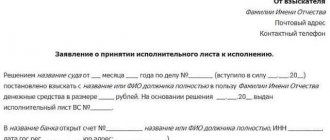What should be included in the receipt?
The document contains the following information:
- city, date of compilation;
- information about the borrower and lender: full name, passport details, registration and residence addresses;
- loan amount;
- the period during which the borrower undertakes to repay the debt;
- signatures of the parties.
You can view a sample receipt using this link.
It is not necessary to have the receipt certified by a notary agency employee. The document will acquire legal force immediately after its signing.
It is recommended that the receipt be written by hand rather than printed. If controversial situations arise, a handwriting examination may be required.
When drawing up a receipt, two witnesses should be invited. They must be adults, capable, and not interested in the transaction. Witnesses also sign the receipt.
Our experts know the answer to your question
Do you want to solve your problem? Consult our lawyer for free the form or numbers :
- Moscow ext. 143
- St. Petersburg ext. 702
- RF ext. 684
The nuances of conducting judicial proceedings by order
In order to collect a debt, a person must comply with a number of rules during the application process. The magistrate who is responsible for issuing the court order also takes into account certain features.
In order for the document to be provided, it is important to take into account the following nuances:
- it is necessary to send an application for a court order to the place of registration of the defaulter;
- The state duty is reduced by half. Sometimes a person may be completely exempt from paying it. The procedure is regulated by Article 333.36 of the Tax Code of the Russian Federation;
- a limit is set on the maximum amount of claims. They cannot be more than 500,000 rubles;
- The magistrate's court may refuse to issue a court order if controversial demands are made and there is a need to present additional evidence to make a final decision. However, the legislation does not deprive a citizen of the right to re-submit an application with a request for a court order or to file a classic statement of claim containing similar requirements;
- if there are no grounds for refusal, the magistrate will make a decision on his own. Parties are not invited to participate in the proceedings. The court order is issued within 5 days. Moreover, the document simultaneously acts as both a recorded verdict and a writ of execution. On the basis of a court order, forced collection of debt can be carried out;
- the completed document is sent to the debtor. The person is given 10 days to appeal. The period begins to be calculated from the moment the court order is received. In order for the claim to be granted, an application for cancellation will need to be submitted. The document records all raised objections.
Video
What are the methods of collecting debt by receipt?
The lender may try to resolve the situation peacefully or resort to forced collection of funds - through the court, debt collectors or the police.
Pre-trial settlement
First of all, you need to contact the debtor and remind him of the need to repay the loan. If he ignored the requirement, a written complaint should be sent to him. It must indicate that in case of refusal to pay the debt, the lender will apply the provisions of Art. 395 of the Civil Code of the Russian Federation, which provides for the accrual of interest in the amount of the refinancing rate.
The longer the debtor avoids financial obligations, the greater the amount of debt.
- If the receipt does not indicate the date of repayment of the loan (or the period is set by the moment of demand), then the borrower must repay the debt within 30 days from the date the lender submits the corresponding demand.
- If the debtor, according to the receipt, must repay the loan in installments, then if the deadlines are missed, the lender may put forward a demand for early payment of the debt.
When communicating with a debtor, it is recommended to record audio or video conversations and take screenshots of correspondence. When talking, it is necessary to name amounts, dates, as well as facts that will later allow the identity of the interlocutor to be identified. It is necessary to ensure that the debtor verbally confirms the amount of the debt and the timing of repayment.
Contact the collector
You can use the services of collection agencies. The company buys out the debt based on an assignment of claims. The lender receives up to 80% of the total debt and is freed from the need to negotiate with the debtor and waste time on legal proceedings.
Go to the police
Police officers are required to accept the application and conduct an investigation. They call the debtor to the police for an explanation. Sometimes this is enough for a person to return the funds.
At the same time, in most cases the applicant is refused to initiate criminal proceedings.
Criminal cases are usually initiated under the following circumstances:
- during the conversation, the debtor confirmed that he never intended to return the funds;
- the debtor borrowed from a large number of people and did not repay the debt to anyone, so many applications were received against him;
- the debtor provided false information about himself - he used someone else’s or a fake passport, indicated the wrong place of work.
Collect a debt on a receipt through the court
Which court should I file my claim in? It all depends on its amount:
- if the value of the claim is less than 500 thousand rubles, you must go to the magistrate’s court;
- if the cost of the claim is from 500 thousand rubles, then the plaintiff is sent to the district court.
You can go to court at the defendant’s home address or at your place of residence.
The statute of limitations for civil cases regarding forced collection of debt is 3 years. It starts counting down:
- from the date of repayment of the debt indicated in the receipt;
- from the expiration of the 30-day debt repayment period after the lender made a demand for payment of the debt.
There is no possibility of obtaining compensation for moral damage. This harm occurs when moral rights are violated, and collection of a debt against a receipt is a property dispute.
Attention! If the debtor agrees with the fact of the debt, and the amount to be collected is less than 500 thousand rubles, then the funds can be collected in a simplified order through a court order.
Preparing and filing a claim
If the response to the claim is negative or there is no reaction to the received document at all, you should proceed to the next stage - judicial. Find out how to win a court case to collect a debt on a receipt without a lawyer in this video:
You can go to court with a request to collect a debt in two ways, draw up and submit:
- an application for the issuance of a court order to collect a debt against a receipt in an indisputable manner;
- a statement of claim for consideration of a dispute regarding the collection of a debt under a receipt.
In the first case, the court considers the case using a simplified procedure that does not involve court hearings and issues an order based on the documents submitted by the applicant confirming the debt. However, for an order to be issued, three conditions must be met:
- Recognition by the court as an agreement of the receipt submitted by the applicant. To do this, it must contain the conditions necessary for written loan agreements.
- There is no dispute between the parties. That is, the debtor does not deny the fact of the debt. Otherwise, he has the right, within the period specified by law, to file an objection and the court will refuse to make a decision to collect the debt or cancel the decision made.
- The amount of debt should not exceed 400,000 rubles.
It is important to know that the advantage of a writ is that a court order simultaneously has the force of a writ of execution.
If a dispute arises between the parties, the case can be considered according to the full procedure by filing a statement of claim. A dispute may arise not only over the existence of a debt, but over the amount of penalties, which most often happens when collecting a debt by receipt between individuals.
When drawing up a statement of claim, it is necessary to indicate all the facts substantiating the plaintiff’s claims, and attach to the statement documents confirming these facts, these include:
- receipt for loan of funds;
- claim sent to the debtor;
- response to the complaint, if any.
Debt collection by receipt from the point of view of the Civil Code of the Russian Federation, Article 395 is discussed in this video:
As a general rule, a statement of claim is filed with the court at the place of residence of the defendant. When filing an application, the plaintiff must pay a state fee.
State duty
The amount of the state fee when filing an application with the court is regulated by Art. 333.19 of the Tax Code of the Russian Federation. So, when filing a claim of a property nature, the law provides for a certain percentage of the amount of the claim. At the same time, the code establishes a minimum duty of 400 rubles and a maximum of 60,000 rubles.
The law gives the plaintiff the right, in case of a positive decision, to compensation for all legal expenses, including payment for a lawyer, an examination, if necessary, as well as reimbursement of the state fee paid.
It is important to know that the court will not automatically decide to reimburse costs, but only if the plaintiff requests it in the filed statement of claim.
Statement of claim and accompanying documents
The claim contains the following information:
- name of the court;
- information about the parties;
- description of the circumstances: date and address of transfer of money, witnesses, failure by the borrower to repay the funds;
- amount to be recovered;
- legislative norms;
- a request to recover money, accrued interest and costs of litigation from the defendant;
- list of attached documents;
- date of filing the claim in court, signature of the applicant.
To recover funds through the court, a sample application is available at this link.
The attached documents include the following:
- photocopy of passport;
- receipt;
- checks, receipts.
If the plaintiff uses screenshots of correspondence as evidence, then he needs to have them certified by an employee of the notary agency. Otherwise, the court will not take them into account.
Drawing up an application
An application for a court order should be completed as follows:
- in the header of the document it is mandatory to indicate the full name of the judicial authority to which the application is being submitted;
- reflect complete information about the claimant: full name or name, place of registration and actual location, residence;
- reflect detailed information about the debtor: full name or name, place of registration and actual location, residence;
- state the essence of the requirements to the debtor, on the basis of which it is necessary to claim funds or property;
- attach documentary evidence (justification) of the requirements, according to the list;
- indicate the total value of the claims, taking into account the value of movable property and losses incurred related to the subject of the claim.
A receipt for payment of the state fee must be attached to the package of documents. Its amount is determined by law and is 50% of the rate that is applied when accepting ordinary claims.
The court has the right to refuse to issue a court order, and this may be motivated by:
- the grounds set out in Articles 134 and 135 of the Civil Procedure Code of the Russian Federation;
- lack of payment of state duty;
- the absence or insufficient composition of documents confirming the applicant’s requirements;
- non-compliance with the requirements set out in the application (Article 122 of the Code of Civil Procedure);
- place of residence (location) of the debtor outside the Russian Federation;
- the existence of a dispute regarding the essence of the stated requirements.
Share with colleagues:
State duty for debt collection by receipt
The state duty depends on the amount of debt:
- if the debt is up to 20 thousand rubles, then the amount of state duty is 4% of the claim price (not less than 400 rubles);
- from 20 to 100 thousand – 800 rubles plus 3% of the amount over 20 thousand;
- from 100 to 200 thousand – 3.2 thousand rubles plus 2% of the amount over 100 thousand;
- from 200 thousand to 1 million rubles – 5.2 thousand rubles plus 1% of the amount over 200 thousand;
- from 1 million rubles – 13.2 thousand rubles plus 0.5% of the amount over 1 million rubles (maximum 60 thousand).
Challenging a receipt
A receipt may be considered hopeless if the amount of the debt is up to 1 thousand rubles, and the document itself was drawn up using threats, violence, deception, or under difficult life circumstances. The injured party is advised to immediately file a complaint with the police, otherwise it will be difficult to obtain a positive decision from the court based only on witness testimony.
A receipt can also be challenged under the following circumstances:
- any party was misled by the conspiracy of a group of people;
- the party was incapacitated, which was confirmed by a court order at the time of signing the receipt.
If the receipt does not contain details or they are indicated incompletely, then the court may recognize it as unidentifiable.
An interested party, when filing a claim in court with a demand to recognize the receipt as hopeless or invalid, pays a state fee in the amount of 300 rubles.
What to do if the deadline for filing an objection has passed
The debtor has the right to challenge the court order by filing objections, which must be drawn up only in writing and submitted to the court office in two copies.
There is a strict deadline for these actions - 10 days from the date of receipt of the document.
For various reasons, the debtor misses the deadline for filing objections, but does not agree with the court’s decision. The reasons can be disrespectful, for example, simple forgetfulness, or they can be valid - illness or business trip.
The judge will not accommodate a forgetful debtor and will not take into account objections filed with a missed deadline.
If the deadline is missed for a good reason, then the objections must be accompanied by a request for an extension of the deadline and supporting documents, duly executed. In this case, the objections will be considered by the judge, and the order will be canceled.
Is it possible to collect a debt without a receipt?
If the lender does not have a receipt, but has other evidence of the transfer of money (screenshots, audio-video recordings of conversations), then he has the right to use all available methods of debt collection. You can contact the police with a statement of fraud, initiate legal proceedings, or transfer the debt to collectors.
Collect a debt from an individual without a receipt
The following evidence must be prepared.
- Video recordings. If the injured party does not have a video about the disbursement of funds, then you can provide a video that records problems with the subsequent disbursement of money.
- Audio calls, SMS messages. Usually they can also be obtained through further negotiations with the debtor. The content of the conversations should indicate the presence of financial obligations from which the debtor is avoiding.
- Any documents confirming the existence of financial obligations.
Application for a court order
In some cases, when considering individual civil cases, a judge may exercise his right and use the issuance of a court order. The document is a resolution to recover property and funds from the debtor in an indisputable manner. For enforcement proceedings, the order is useful in that it allows you to significantly reduce the time for documentation, simplify the collection procedure as much as possible and quickly obtain the final result - execution of the court decision, and the plaintiff only needs to draw up an application for the issuance of a court order.
An example from judicial practice
Smelnikov I.A. filed a lawsuit, demanding to collect a debt in the amount of 50 thousand rubles from the defendant R.V. Zhelezov. The money was transferred by Smelnikov as a loan without issuing a receipt. In order to prove the existence of financial obligations, the plaintiff provided the court with a printout of a lengthy 4-month correspondence, certified by a notary. In SMS messages, Smelnikov regularly reminded the debtor of the need to return the funds, and Zhelezov replied that he did not have the opportunity to pay the amount.
At the trial, the defendant stated that he had no obligations to the plaintiff. However, the court granted the claim because it received sufficient evidence of the debt.
Share with your friends:








